NEDA FIRFOVA TALKS ABOUT AUTHORSHIP AND THE ARTISTS’ BOOK
Published on: 24.05.2018
An interview with Neda Firfova, result of an e-mail communication in the period January-May 2018, Private Print Talks.
In the practice of the artists’ book, in the context of the Macedonian contemporary art, the artist Neda Firfova (1981), although based in Tokyo, Japan, probably goes the furthest in the research of this medium. She describes her work as a “research within the print medium, its production modes, the paper and the multiplication as symbols of the established truth, at the same time exploring their relations with architecture, design, the human body and, in general, the existence through distinct historical periods and contexts”.
Neda defines herself as a graphic designer who approaches this profession from the aspect of a researcher. Her idea is to redefine the authorship in this profession within the contemporary context and give voice to the exclusivity that graphic design carries historically, through the multiplication and the print medium, with the goal to improve its role in society and its cultural value.
She is the author of a number of artists’ books, both independently and as part of larger research projects, while she has also participated in collaborative projects involving this medium. This short conversation focuses precisely on her understanding of authorship and the artists’ book.
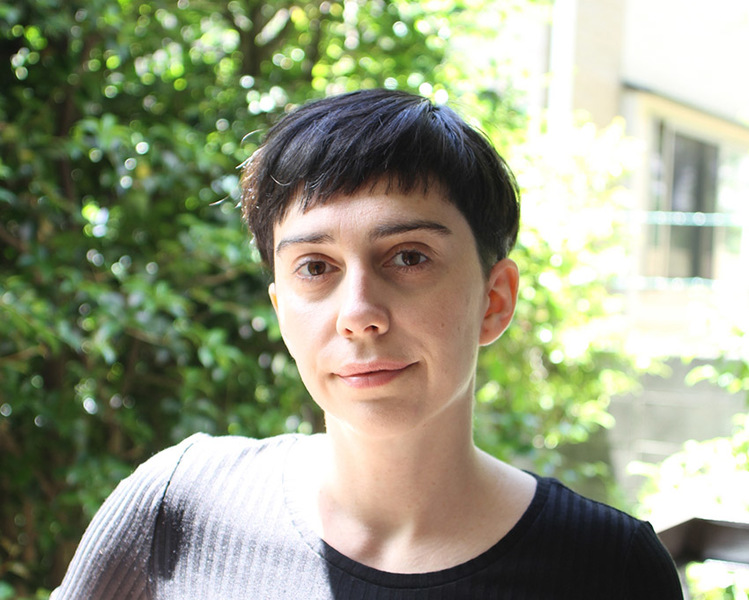
Neda Firfova
PP: As an artist, you work with the book as an artistic expression. You’ve designed and authored a lot of projects of this kind. We are interested to know how such work defines your understanding of an artwork?
NF: Having in mind my productions articulated in the form of a book, or created through processes aiming to replicate or modify already existing printing modes and productions of book objects, I come to the conclusion that to me, the book as a work inevitably undergoes three phases.
The first one is variable, let’s call it a process, a prefix, or practice. It can represent a research, a purpose for creating the art or the design object, or, better yet, an already existing daily practice of work related tasks that eventually create the conditions for the production of the book as an object.
The second is the book object itself.
And, the third phase is the extension of the book object. This is, of course, the reading of the object, the spectrum of thought that this object evokes in any individual who comes into contact with it. If a book eventually seeks for an individual to spend an intimate time with it in personal interpretation of its content, I am interested in the space and the context in which these objects are paged through, read, kept, and displayed. For the extension to become an integral part of the artwork, it is necessary to be articulated and reflected through the book object itself, or to become performative or visible.
PP: According to the phases of the creation given above, does the book object come as a result of the research, or is the form (book) itself the subject of the research?
NF: The book, as a form, everything that it represents, but also the processes of its physical creation, can be the subject of research, as well as part of a practice that creates the conditions for a new work. This is the case with my works Always Ready and Redressed, in which a book created for one project, becomes a kind of a precondition, but also a readymade to which interventions are made in another project.
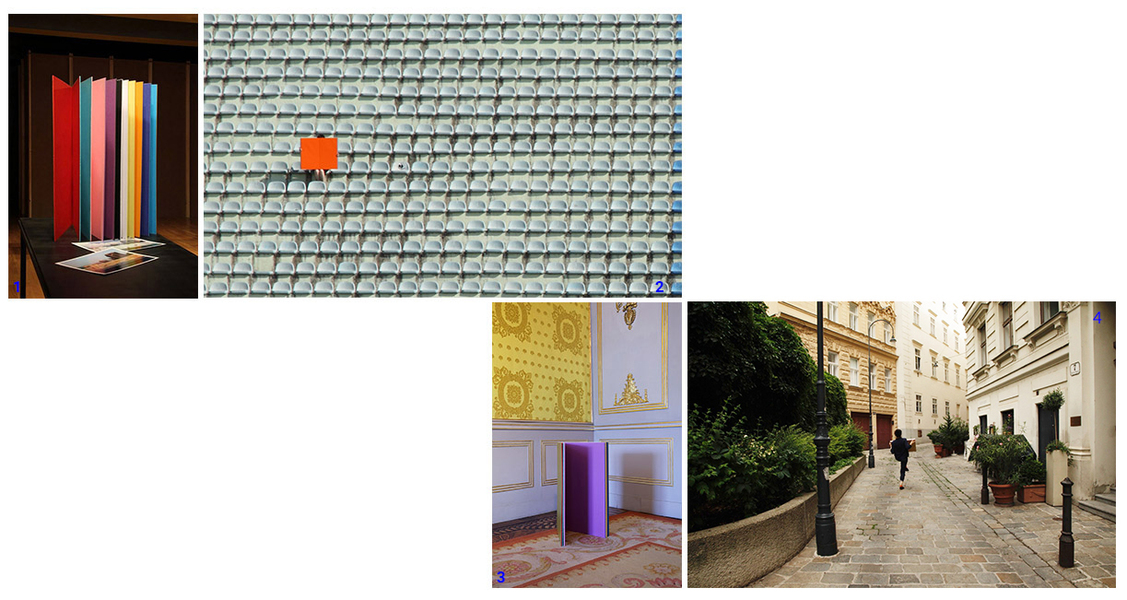
1 Always Ready, Hand-made and hand-bound book object, KKA Artist in Residency, Vienna 2015 (Photo©KulturKontakt Austria)\ 2 Always Ready, Documentation of the performance, Qemal Stafa Stadium, Tirana 2012 \3, 4 Redressed, Documentation of the project 2015
PP: In your project titled Always Ready, it is very clear that the context (i.e. the third phase) is included in the thoughts behind the project itself, but in your work Redressed, the same book is put in the context of another concept. How is this extension, or re-contextualization, of the product (in the work Redressed) connected to the initial idea of the given artist's book (i.e. with the first and the second phases)?
NF: In Always Ready, the construction of the book went in parallel with the planning of the performance with the same name, both are inseparable. In the project Redressed, on the other hand, I take the book that was central to the project Always Ready as a readymade that carries certain meanings and knowledge due to its previous existence, but also due to the research which was part of it. The book from this project is a symbol of the deleted design history and the non-transferred modernist knowledge due to its own tragic context – the collective amnesia after the fall of the communism in Eastern Europe.
Considering it as a symbol of a disrespected history, in the project Redressed, I redressed it in a baroque dress and took it out of context. This gesture of mine, of course, imitates the vulgar and violent act of the Macedonian authorities in power at the time, which redressed in baroque some of the symbols of the local modern architecture, i.e. design (that is actually created throughout the same period with the mass games and similar mass events), and thus, once again, made a symbolic and violent break in the continuity of the knowledge in the field of the design from one important period – a new attempt for a new cultural amnesia.
The interesting thing about this project is probably the fact that the book object is not only a central part, but it is also an active part of the process. The redressed book in golden cover is the result of the practice of handmade work on the book objects produced over the years for the needs of Always Ready and for the necessity of its interpretation in a new context. But, Always Ready and Redressed are actually intertwining on several levels as well. For example, the poems All Points Addressable: 4 Sentences 4 the Designer and the General by the poet Christian Hawkey, created for Always Ready are the other part of the connective tissue that binds the two projects, their content touches upon the re-contextualization that followed.
In this sense, the process is the new context (and the old book), the redressed book object, i.e. the creation of a new one, is the central production, while the extension is the photo documentation that dislocates the book object to the place where it is imagined as a baroque artifact in the space of the Albertina Gallery, trying to create a new narrative for the history of this object.
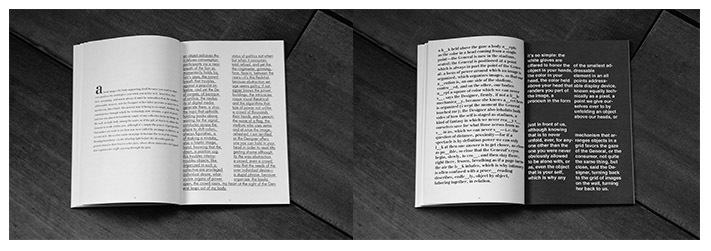
ALL POINTS ADDRESSABLE: 4 Sentences 4 the Designer and the General, Christian Hawkey with interventions by Neda Firfova, documentation from the exhibition catalogue Always Ready: A project by Neda Firfova, 2014
PP: Is it possible to summarize the term extension tracing it through some of your other projects?
NF: The publication Extra Artisan Trade Workshop Export Complete Import Programme (A Book for the future), also provides an extension. It is my authored book co-published by the press to exit project space, and documenting some of the handmade signs of the artisan workshops in the Old Bazaar in Skopje. This selection of neon or painted signs is documented with the aim of preserving their existence through the transition period, which also announced their gradual disappearance. With the idea of giving voice to the perpetuating power of the book as a medium, I designed and produced it in a way that the photographs of the chosen signs are completely hidden, i.e. invisible, until the reader decides to scratch the protective layer. This can happen at any given moment in the future and in any way in which the reader decides to do it. Potentially, this can be a future in which none of these signs will exist anymore.
Having this aspect of the book in mind, I organized performative events titled Scratch & Wine, to which I was inviting local artists, designers, and activists to intervene in the books, while a discussion was being held at the table about the social importance of this graphic “dialect”.
Despite being published in several different forms, the project GRIDS also provided an extension through different print media. The project deals with creation of new and recreation of already existing typographic matrices of modular alphabets which, among other, also represent language schemes that can potentially be filled with text, even physically. Some of the matrices were exhibited in gallery spaces in the form of wallpapers or floor posters, to which the visitors were invited to intervene. The interventions were used as part of the future development of the project.
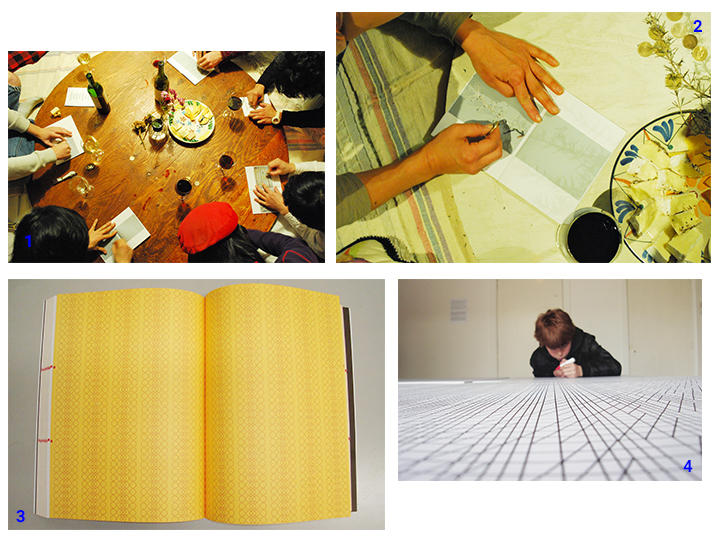
1, 2 Scratch & Wine, Interactive-performative event, Vacant, Tokyo 2009 \ 3 GRIDS, published in a book project by press to exit project space 2008 \ 4 GRIDS, Interactive-performative event and solo exhibition, KijkRuimte, Amsterdam, The Netherlands 2012
PP: What is your experience with the practice of this medium in Japan?
NF: Considering that I practice the production of the artists’ book as a designer, artist, and educator who comes from Europe, but lives and works in Japan, I often find myself in a situation where my students and I discuss the parallel development and the historical differences in the field of the printed media and the visual culture in Europe and Asia.
There are multiple and diverse examples, but as far as the artists’ book as a medium in Japan is concerned, and especially when a comparison is made with the European history of the artists’ book and the print media, in general, the productions from the Edo period are truly interesting. The ‘mass’ production enabled by the woodblock printing as a technique was developed at the time, so the decorative rolls created for the homes of the privileged classes were replaced by Ehon (絵-picture 本-book), printed illustrated books depicting scenes from the everyday life in Ukiyo-e style (浮世-fleeting life and 絵-picture).
These artists’ books were intended for and enjoyed in all segments of the society, and it is my personal opinion that they were not only a popular art form at the time, but they also represented a truly democratic and liberating medium in the period of the strict military system. A good example of this are the Shunga books, erotic humorous illustrated books, which were owned by both women and men in a family, and were shown with pride to their guests.
Having in mind that in Europe, on the one hand, the first printed books on the Gutenberg press were the 42-line Bibles whose cost equaled several years’ salaries, and in the 16th and the 17th centuries typography and scholarism are already fully fledged with the goal of producing knowledge through multiplication, a completely different historical thread can be observed, which, it seems to me, has strongly marked the visual of the culture here. The blend of the artistic and the informative through such an informal medium as the Japanese illustrated book differs a lot from the strict European educative approach to books, both in the early printing period and in the period after the industrial revolution, when the exclusive ‘beautiful’ books appear as a reaction. This immediacy seems visible even in contemporary terms, despite having the privilege today to apply all the benefits of the printing medium on a global level.
Researching the existing knowledge and having in mind that the contemporary production of books and artists’ books requires knowledge of the global processes in the industrial printing and production of paper, but also of the alternative ways of printing and local concepts of handmade book binding, together with the students of my studio at the Faculty of Design and Architecture at the City University of Nagoya, every year we work on a group experimental student project aiming to produce an artists’ book. The project comprehends a social topic that the students can especially closely relate to, and then they find a way to translate it into authored visual material, which, in the end, is printed and published. Through this process, I tend to see the medium of the artists’ book as an open educative method as well.
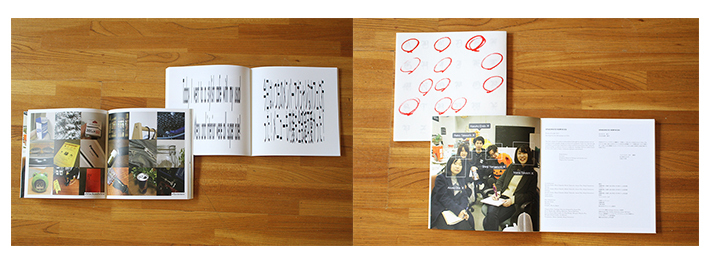
Analogue Services (AS) is a translation of social networks modes on paper surfaces. Produced by the students in Neda Firfova’s graphic design seminar, School of Design and Architecture, Nagoya City University, 2017
PP: From this experience, both as an artist and as an educator in the Japanese cultural context, could you tell us how the artists’ book in the contemporary Japanese culture, aside from the popular modern understanding of the manga, builds upon the tradition, what are the forms in which it appears, what are the directions in which it moves?
NF: I think that the historic presence of Ehon, but also the preservation of this cultural heritage is of significant importance for the contemporary production of books in many fields. If we look at this medium as a carrier of image and text at the same time, where these two elements are in such relation that aims to play with the language before the eyes of the reader, its historical development can mostly be traced through publications in the area of poetry. I would say that part of the precursors of the contemporary Japanese artists’ books come from this direction.
The other strong influence can be found in the developed photographic production and the popularity of photography as an artistic medium, which is due to the omnipresence of the photo cameras as part of the lifestyle and the local production in this field. The photobooks already have a long history and a high cultural value. Their production requires specific knowledge in the area of printing and use of paper, and special precision in the finishing process, which has high standards in place for the remainder of the printing production, which also includes the artists’ books.
We can discuss whether the production of the artists’ books should include graphic designers, but it is also worth mentioning the local understanding of graphic design and, again, its presence and rich local cultural context and history.
On the one hand, all these highly culturally and historically appreciated branches create extraordinary pre-conditions for an inventive production of contemporary artists’ books, but maybe they also set too high standards for a medium that is in its essence conceptual. This, of course, also means higher production costs that are hard to bear for the independent publishers and artists. I think that these are the main pre-conditions in the creation of the diversity, versatility, and expansibility of the art book market in Japan, but also its democratization. Exclusive gallery editions are sold shoulder to shoulder with self-published and no-ISBN productions, and the vast audience with its collector’s spirit has managed to help the independent production stay in a healthy condition throughout the last decade.
It is not easy for me to establish a strong common feature, regarding the format and the content, which separates the Japanese productions from those present in other countries, but having in mind the influences in the production and the general context, I can certainly notice that, on the whole, the Japanese artists’ book is less political, engaged and esoteric, and more playful, visual, tactile, and communicative.
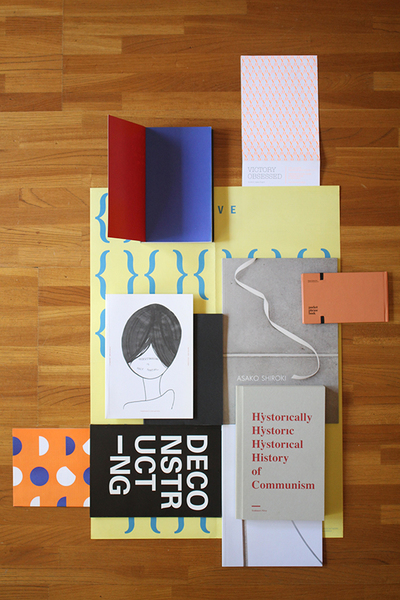
Selected graphic design productions by Neda Firfova
PP: How and to what extent does graphic design help your artistic intentions, and where and to what extent do these two aspects overlap in your practice?
NF: To me, these two categories are in constant communication. The self-examination as a designer and the motive of redefining what it means to be part of this profession through different social contexts and periods is, in fact, a recurrent theme in my artistic practice.
As we are already talking about artists’ books, I will give an example related to them, regarding the way in which my practice as a graphic designer feeds my activities as an author. Namely, as a graphic designer I have worked on quite a few artists’ books by other artists, books about art projects, exhibition catalogs, and so on, and in these collaborative projects, apart from the defined designer role, I feel that another role is entrusted to me, that is, the role of an interpreter. It is precisely this interpreting, which takes place through the graphic designer for a certain artistic thought or work to be translated into a book, that becomes visible and inseparable from the produced artists’ book as a work.
Finally, these interpretations can also be considered as extensions, similar to my artworks, they are integrated in the work as a parallel layer. It is in this space that the performativity of this profession yearns, which is a truly thrilling category for me.